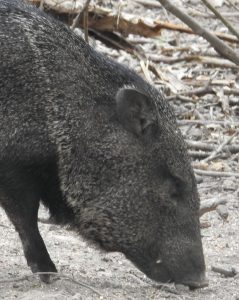A javelina is not a pig. It’s not even in the same family.
Though the rather pig-like javelina (Pecari tajacu)—a lean, compact native creature with a bristly salt-and-pepper coat—inhabits the same local brushlands as the invasive feral hog, the two certainly differ. And the javelina, mainly a fan of prickly pear and succulents, is far less destructive.
While both species share the same order, Artiodactyla—for even-toed ungulates, or hoofed mammals—javelinas (also called collared peccaries) occupy the family Tayassuidae. Hogs (Sus scrofa)— introduced in the 1500s from Eurasia and northern Africa—are in the family Suidae.

Here are a few differences. The smaller javelina has a straight, minimal tail, short ears and a bushy whitish “collar” or neck band. It has only three back toes, to a hog’s four. While a hog has curved canine teeth, or tusks, a javelina’s are straight and, as its name indicates, javelin-like.
Javelinas, highly sociable creatures, usually live in herds of about 9 to 12, but, in expansive, cactus-rich lands, sometimes from 20 to 30. They thrive in brushlands with heavy undergrowth in West and South Texas, particularly where their favorite food, prickly pear, abounds; both its fruit and pads offer not only fuel, but also water, enabling them to survive in parched lands. Though javelinas can swim, they do not appear on South Padre Island, perhaps due to a dearth of cactus.
Employing snouts and sizeable canines as shovels, javelinas dig and rip up mainly cacti and succulents, leaving pits and mangled messes in their wake. Sometimes they unearth ornamentals, to the dismay of gardeners—plants javelinas may abandon unless attached to tasty bulbs. Mesquite and paloverde seed pods, as well as insects and other small creatures, round out their menu. Indifferent to grass, javelinas, unlike hogs—which consume not only that, but food crops and the occasional lamb or goat— don’t compete with cattle. However, some hunters dub javelinas “corn vacuums” since they’ll devour corn set out for deer. Javelinas forage in early mornings and evenings during hot weather and midday when it’s cold.

Gregarious javelinas huddle and groom one another, rubbing their noses along backsides for the pungent musk emitted from glands above tails. This, along with wiping the musk on rocks and stumps, apparently solidifies herd bonding. Javelinas travel in single file, following each other’s steps, squashing plants, and constructing oft-used trails. When alarmed, they scatter— typical of herding animals—which baffles coyotes and bobcats, hindering their attacks. To express alarm or threaten an intruder, or one another, a javelina chatters its teeth, growls and bares canines. When scared, it may give a fearful “woof”. Frightened members of a dispersed herd may bark, then grunt upon reuniting. Javelinas rest in the shade of desert flora on hot days. At night, they snuggle for warmth.
Only the dominate male javelina breeds, and a litter usually consists of from one to three; twins are frequent. Babies, called “reds” for their reddish fur, follow their mothers shortly after birth—unlike feral hogs, whose newborns are quite helpless. A javelina may breed twice a year, particularly when food is plentiful. Mothers, with assistance from the herd, are fiercely protective.
Ranchers prize javelinas for their control of prickly pear, but not for the many holes they dig and fencing they damage. But some profit from hunting leases. Many locals enjoy lean javelina meat, especially in tamales, stew or chorizo.
Sadly, a javelina, armed with spear-like canines, may slash a cherished dog, sending it to the vet. A javelina will not provoke a fight, but it will soundly defend itself, and a wise dog avoids the animals afterwards. Texas considers javelinas game animals which—unlike invasive and destructive feral hogs, for which hunters face minimal restrictions—must be hunted in season with a license.
Like most wild creatures, habitat loss and territorial fragmentation have had a toll on javelinas over the years, reducing their range, but the bold, grizzled beasts appear to be thriving here in the Valley.